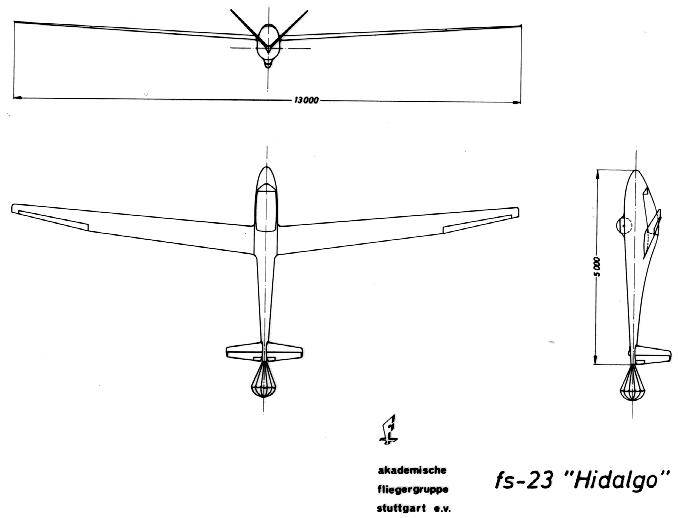New Materials, New Specifications
Work on the Hidalgo ran from 1953 till 1966. For some time, the project was put on hold to allow the group to focus on building the fs24. Afterwards, the project was restarted with a new design.
The concept of the Hidalgo didn’t fit into any of the international performance classes for sailplanes. Instead, it was designed to fit into the then much discussed 13m mini-standard class. Noteworthy features of the Hidalgo include a wing swept 5° forwards, a V-tail, and a drogue chute in the tail instead of airbrakes. The final design, which had a short wingspan yet high aspect ratio, led to stringent requirements in terms of materials. This all led to the aircraft having an empty weight of 102 kg at a time when sailplanes generally weighed 1.5 to 3 times as much.
Examination of material and parts was the largest chapter so to speak of the Hidalgo project. While the strength values and other characteristics of wood and metal can be found in literature, the same couldn’t be said for GRP with balsa or birch veneer. Experiments were therefore run, where every fiberglass fabric type, sandwich samples with differing strengths, and configurations with differing amounts of fabric layers were tested for tensile, pressure, and shear strength along with elastic modulus and type of failure. These extensive tests allowed for the creation of a table of the material’s characteristic values, enabling further work on the aircraft.
Flight tests showed that the fs23 possesed good flight characteristics. It was responsive, easy to slip, gave adequate stall warning, and could easily exit a spin after only 1/3 or 1/2 rotations.
Throughout its life, the fs23 received multiple modifications. In 1967, during flutter tests for the tail, the aircraft suffered its first accident. The Hidalgo flipped over on its head, ejecting its pilot. He later said of the incident: “There was a ‘Whoosh’ and suddenly I was out in the open!”. Since the aircraft surprisingly landed quite well by itself, it was decided to repair the plane and return it to service, though it received a strengthened tail just in case. Tragically, the Hidalgo met its end in a fatal crash in July 1971, killing its pilot Heinz Jahn.
Specifications
| Construction | 1953 – 1966 |
| First flight | 1 February 1966 |
| Construction method | GRP-Balsa Sandwich |
| Wingspan | 13 m |
| Wing area | 7 m² |
| Aspect ratio | 24,1 |
| Profile | FX 61-184 at 0,045 b/2 FX 61-168 at 0,23 b/2 FX 61-147 at 0,70 b/2 FX 60-126 at 0,88 b/2 |
| Dihedral angle | 3° |
| Wing sweep | -6° (t/4) |
| Wing taper | 0,33 |
| Aileron area | 0,23 m² |
| Tailplane area | 0,735 m² |
| Length | 5 m |
| Height | 0,89 m |
| Empty weight | 102,5 kg |
| MTOW | 190 kg |


